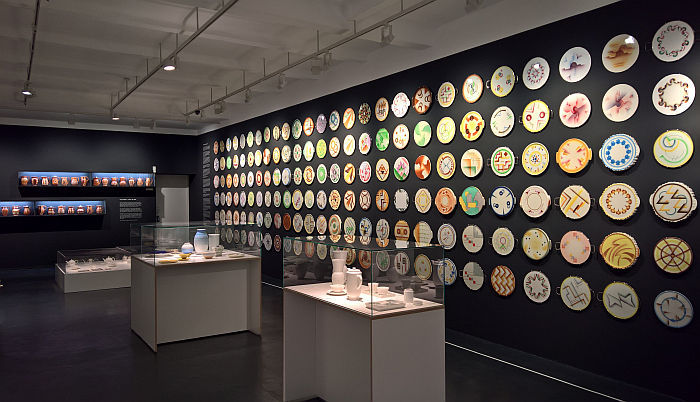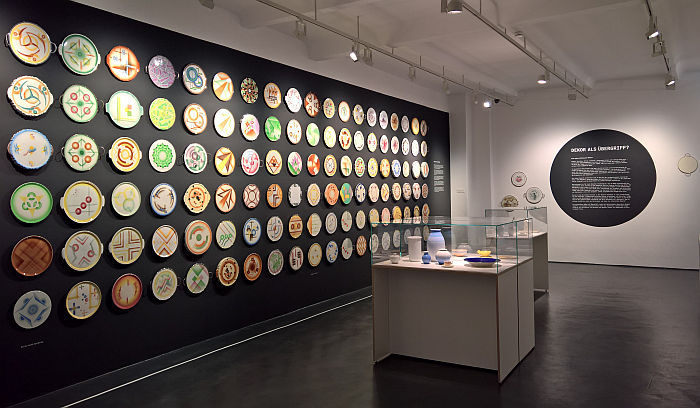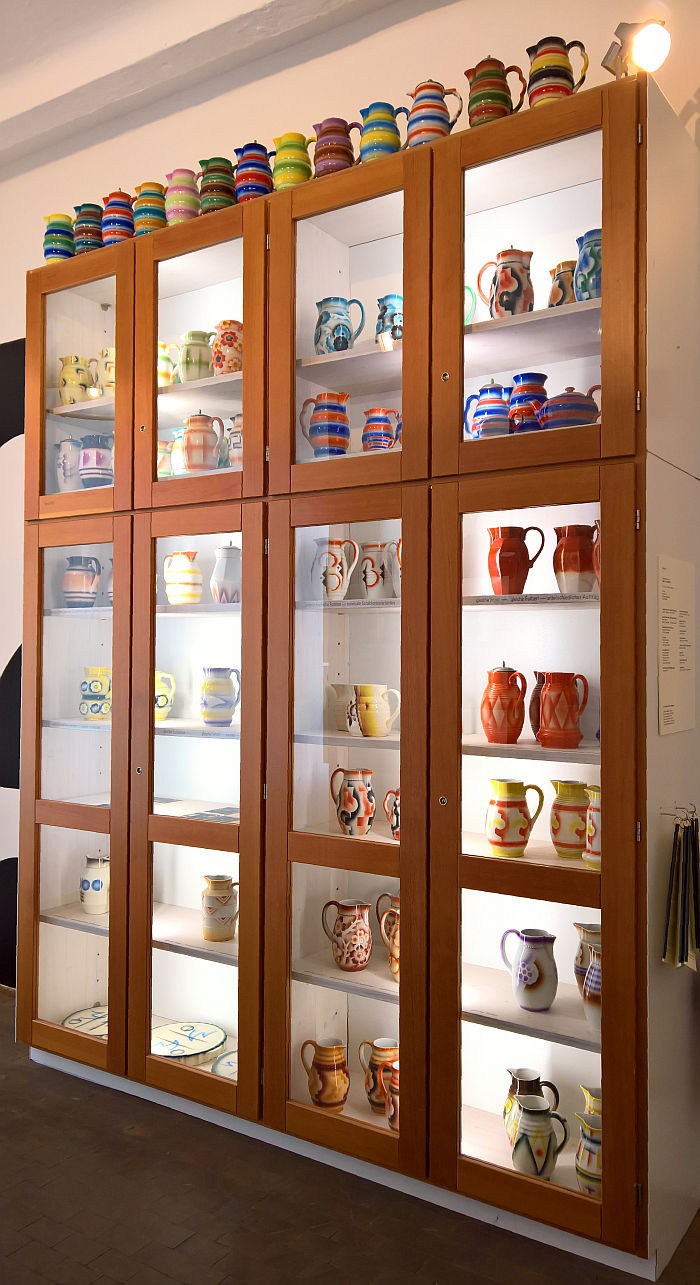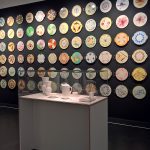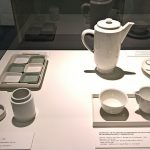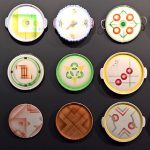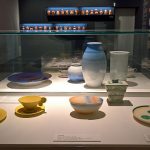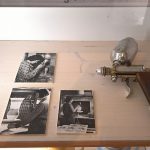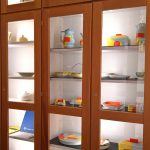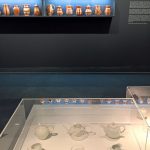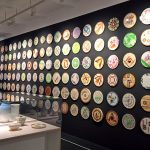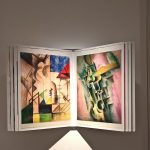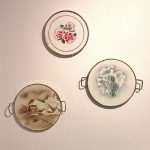Decoration as Trespass? @ the Werkbundarchiv – Museum der Dinge, Berlin
For all the popular associations of the inter-War years with the reduced and the paired down, with objects whose value was deemed inherent rather than something one added, one must remember that the inter-War years were also a period that brought forth the colours and confusions of Surrealism and the glitz and glamour of Art Déco: The Roaring of the Twenties being as much about a self-confidence of expression as a joyous relief that the war years were, once and for all, over.
And thus that both the reserved and the ornate existed side by side in the inter-War years, if not necessarily comfortably; and this tension between decorative ornamentation and a more reserved understanding of design are explored in the Werkbundarchiv – Museum der Dinge’s exhibition Decoration as Trespass?
Completing the Werkbundarchiv – Museum der Dinge’s trio of exhibitions exploring developments in design understanding(s), the development of design vocabularies, in the early decades of the 20th century through the twin perspectives of the Deutsche Werkbund and Bauhaus: an, if you will, exhibition triangle as opposed to cycle, that began with Commercial Design instead of Applied Art? and its explorations of inter-War commercial graphic, typographic, design; moved over Unique Piece or Mass Product? and the associated questions of production, form, aesthetics; and which culminates in Dekor als Übergriff? – Decoration as Trespass? – and a discussion on the, relatively, short lived, but both influential and instructive, genre of spray decorated stoneware: a genre that arose in the 1920s and a genre introduced in Decoration as Trespass? by a truly outrageous, thunderous, wall of …….. cake platters! No honest. And as glorious a sight as you’ll see in a museum, a genuine Übergiff, as in assault, on the senses, in a positive, joyous sense one understands.
Created around 1930 and originating from seven manufacturers from across Germany, a distribution which tends to underscore the popularity, or at least size of the (perceived) market for such products, the abstract, geometric decoration of the cake platters allows for an unequivocal illustration of a genre of spray decorated stoneware, but for all provides a clue as to one of the reasons why inter-War manufacturers were keen on the genre: variety. Scanning the platters one quickly identifies repeating patterns, or more accurately, the same patterns in different colours and/or combinations, while in a nearby cabinet a wider array of objects, for all cocoa jugs, very satisfyingly elucidates not only the process of applying spray decoration, and the role of templates in applying such designs, but also illustrates how any given template functioned differently depending on the form of the object and that in the course of a production run the colours could be changed: thereby allowing for easy variety within mass, industrial, production. A principle which not only nicely reflects one of the advantages of 3D printing in contemporary industrial production, but also the post-War position of a Rudolf Horn and his opinion that in order to respond to the needs of a diverse society the furniture industry should offer “weniger Typen mit mehr Varianten” “less types with more variants”
Spray decorated stoneware allowed just that in context of ceramics, allowed for the production of affordable, mass market, ceramic goods, in a variety that met the varying demands of varied consumers, and that not just ceramics, but was also a process utilised, for example, by Marianne Brandt for many of her early 1930s metal products for Ruppelwerk Gotha, and, and just as importantly, allowed for a move away from the handcraft exclusivity of the conventional porcelain industry, was a process that, and much like Michael Thonet’s wood bending process, could be run on an industrial scale with suitably trained, but not necessarily highly qualified, workers, and thus stands as a very neat example of the understanding of machine production for the benefit of the masses, for the democratisation of design for a new democratic age, as advanced in the inter-War years.
And advanced for all by the likes of the Deutsche Werkbund………
………..
………..
…………..if it wasn’t for the ornamentation and decoration.
The Deutsche Werkbund weren’t keen on ornamentation and decoration.
Or at least not officially, amongst Werkbund members there was however an attraction to ornamentation and decoration.
And such differences in understandings of the value, or not, of ornamentation and decoration form a central pillar of Decoration as Trespass?, the conflicting attitudes towards ornamentation and decoration, for all within the ranks of the Deutsche Werkbund.
In addition to the anonymous cake platter artists Decoration as Trespass? also features works by three named designers: Martha Katzer, who in the inter-War years was particularly associated with the Majolika ceramic works in Karlsruhe and where she is popularly credited with introducing and advancing spray decoration; Artur Hennig who aside from his own work is also presented through his teaching at the State Ceramics College Bunzlau and mention of the developments of the spray decoration process and spray pistol aesthetics he and his students developed; and Margarete Heymann through examples of her work for her Haël-Werkstätten für Künstlerische Keramik in Marwitz, work which reminds of the exhibition Bauhaus in Brandenburg at the Dieselkraftwerk Cottbus, which in addition to objects by Margarete Heymann also features brightly coloured, hand-painted, works by Werner Burri and Theodor Bogler for the Steingutfabriken Velten-Vordamm.
Margarete Heymann, Artur Hennig and Hermann Harkort, who established the aformentioned Steingutfabriken Velten-Vordamm, were Deutsche Werkbund members, and that their work went against established Werkbund conventions is very neatly explained through examples of the Werkbund’s conventions, including a copy of the catalogue from the Werkbund’s, somewhat programmatically titled, 1924 exhibition Die Form ohne Ornament – Form with Ornamentation; the Staatliche Porzellan-Manufaktur Berlin’s 1930 Porcelain for the New Home collection by Marguerite Friedlaender-Wildenhain and Gerhard Marcks, very sober if expressive, organic, objects, which, we learn, were inspired and informed by the company’s laboratory division and was described as “vorbildlich” “exemplary” by the Deutsche Werkbund; and a discussion on the Werkbund’s 1932 Wohnbedarf exhibition in Stuttgart, including reserved, undecorated, objects by Hermann Gretsch for Arzberg porcelain or Wilhelm Wagenfeld for Schott & Gen. Jena, and the exhibition’s position that consumers had to move away from an understanding that “a plate with floral decoration or a gold rim is more valuable and more beautiful than an exclusvely white plate”.
And thus positions which in discourse with works by Heymann, Hennig et al underscore the different understandings of decoration in context of household goods that existed in the inter-War years.
A much more direct, brutal, illustration of the tensions of the period being found in the 1931 painting Escape from the land of kitsch by Staatliche Porzellan Manufaktur Berlin porcelain painter Willy Papenfuss depicting the company’s new managing director, and Werkbund member, Günther Freiherr von Pechmann sailing away from a land of colour and flowers to a monotone industrial landscape; from a now of painted, decorated, ornamental porcelain to a future of functional, rational porcelain. And no, Willy Papenfuss wasn’t/isn’t wishing Günther Freiherr von Pechmann a bon voyage.
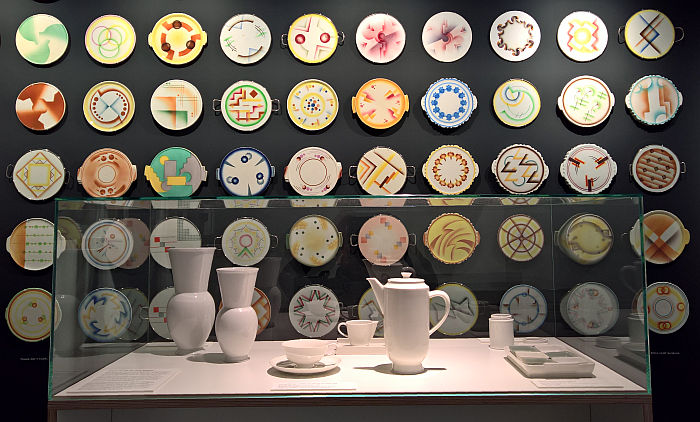
Porcelain for the New Home by Marguerite Friedlaender-Wildenhain & Gerhard Marcks for the Staatliche Porzellan-Manufaktur Berlin, in front of cake platters, as seen at Decoration as Trespass?, Werkbundarchiv, Museum der Dinge, Berlin
Complimenting the objects, both ornamented and not, Decoration as Trespass? also presents numerous quotes from early 20th century protagonist such as, and amongst others, the Austrian architect and designer Adolf Loos, (against ornamentation, very, very, much against) or Bauhaus Meister László Moholy-Nagy, (in favour of spray decoration), and quotes which indicate the nature of the debate and underscore the positions represented; and which above all indicate how far removed the two sides were from another. We’re not saying the spray decoration conflict was as fundamental as the 1914 typology dispute, or would have led to such a split in the Werkbund, but it was an issue, and would arguably have continued to be so, were it not for the fact, as the curators note, that as quickly as it arose in the mid 1920s, spray decorated stoneware quickly faded in the early 1930s: a large part of the suspicion in the exhibition falling on the NSDAP and their preference on a more traditional aesthetic and craft over machine production.
Yet, and, as we noted from Design of the Third Reich at the Design Museum Den Bosch, the NSDAP weren’t adverse to appropriating modernist practices and ideas when it suited their malevolent, nefarious, needs; and arguably affordable, mass market, stoneware with reinforcing, normalising, NSDAP imagery would, one imagine, have done just that, arguably such could have been an interesting tool, for example, in context of the works canteen crockery developed by Schöheit der Arbeit. And so while the, let’s call it, for the purposes of brevity, “traditionalist” position of the NSDAP unquestionably played an important role in the move away from spray decorated stoneware. Other factors may also have played a supporting role.
A clue as to possibly other factors being found in the 1933 book Gutes und Böses in der Wohnung – Good and Bad in the Home – by Carl Burchard, a book very much in tune with the position of the NSDAP, the sort of exhibit one could expect to find in Design of the Third Reich, unquestionably would hope to find in any future exhibition of Domestic Design of the Third Reich, and a work which not only criticised spray decorated works but also took issue with decoration and ornamentation on home crockery in general, be that abstracted or naturalistic images, and a book which, in many regards, urged consumers to move away from an understanding that “a plate with floral decoration or a gold rim is more valuable and more beautiful than a exclusively white plate”. And thus a book which indicates the NSDAP appropriated the (more or less) ornament-free position of the Deutsche Werkbund.
And thus, thus a book which neatly demonstrates that the NSDAP weren’t adverse to appropriating modernist practices and ideas when it suited their malevolent, nefarious, needs.
Which isn’t to say the Werkbund assisted the NSDAP, it isn’t, even if the history of the Werkbund in the 1930s is relatively complicated – dissolved by the NSDAP in 1934 and then, effectively, reformed in 1935 in line with the positions of the NSDAP, and with very little internal resistance to the new NSDAP line, under the leadership of the aforementioned Hermann Gretsch; is however to say that, and as we opined from Den Bosch, that properly understanding the use of design by the NSDAP means moving away from understanding it only as the folkloric and classic and understanding it more as a component of inter-War modernism. Or put another way, the question as to why the Schönheit der Arbeit crockery on display in Den Bosch is, essentially, undecorated is (potentially) important. Certainly interesting. To decorate or not was an argument that had been bubbling along for most of the 1920s, and in 1933 was, as Decoration as Trespass? clearly explains, a position one took as a porcelain designer. The canteen crockery in Den Bosch was, in all probability, designed by Heinrich Löffelhardt, who in 1937 left Schönheit der Arbeit and joined, the aforementioned, Wilhelm Wagenfeld in Weisswaßer and later succeeded Gretsch at Arzberg. Which isn’t the career of someone keen on decoration.
And in context of Decoration as Trespass? could lead one to understand the NSDAP taking on, appropriating, the ornament-free position of the Werkund as a means to erasing the abstract, expressionist, entartet, Roaring, decoration of the 1920s; if you will, to completely misappropriate the position of Adolf Loos that “evolution of culture is synonymous with removing the ornament from the objects of daily use.” And the NSDAP have a well recorded history of cultural and symbolic misappropriation.
But we’re hypothesising, and far, far out our depths………..
……..what is much more certain is that without the rise of the NSDAP, the war and subsequent evolutions in needs, requirements, understandings of consumer and household goods, spray decorated stoneware would have remained an important market throughout the 1930s and into the 1940s. For as Decoration as Trespass? makes clear, consumers were buying spray decorated stoneware, thus neatly underscoring the understanding from SPACES. Interior design evolution at ADAM Brussels Design Museum, or Moderne am Main 1919-1933 at the Museum Angewandte Kunst Frankfurt that in terms of understanding developments in design it is just as important to consider what consumers actually bought as much as what architects, designers, magazines, museums and/or institutions such as Bauhaus or the Deutsche Werkbund were promoting and propagating. The two are/were rarely the same. Alone dictatorships have the power to enforce what is consumed. And Instagram.
Beyond the stoneware and the arguments Decoration as Trespass? pleasingly expands its narrative to also include a collection of early 20th century expressionist, cubist and related, prints by the likes of Josef Čapek, August Macke, Piet Mondrain or Juan Gris, prints in which one can find reflected the forms, colours, expressions on the cake platters and which in doing so provides a little artistic context; and also, and a regular and very pleasing feature of Werkbundarchiv exhibitions, a reading corner with examples of early 20th century magazines, exhibition catalogues, books and newspaper articles, including Adolf Loos’s 1908 polemic Ornament and Crime, and which all aids and abets the deepening of the understanding, and thereby nicely deepens and expands a concise but very satisfying exploration of spray decorated stoneware as both a product genre but for all as a conduit for approaching a better understanding of the debates and discussions surrounding ornamentation in the early decades of the 20th century.
For all the understanding that there were discussions.
Decoration as Trespass? runs at the Werkbundarchiv – Museum der Dinge, Oranienstraße 25, 10999 Berlin until Monday February 10th
Full details can be found at www.museumderdinge.org
- Decoration as Trespass?, Werkbundarchiv, Museum der Dinge, Berlin
- Porcelain for the New Home by Marguerite Friedlaender-Wildenhauin & Gerhard Marck for the Staatliche Porzellan-Manufaktur Berlin, as seen at Decoration as Trespass?, Werkbundarchiv, Museum der Dinge, Berlin
- Cake platter, as seen at Decoration as Trespass?, Werkbundarchiv, Museum der Dinge, Berlin
- Works by Martha Katzer, Artur Hennig & Margarete Heymann, as seen at Decoration as Trespass?, Werkbundarchiv, Museum der Dinge, Berlin
- Spray pistol and spray decorators, as seen at Decoration as Trespass?, Werkbundarchiv, Museum der Dinge, Berlin
- Cake platter, as seen at Decoration as Trespass?, Werkbundarchiv, Museum der Dinge, Berlin
- Various spray decorated objects, as seen at Decoration as Trespass?, Werkbundarchiv, Museum der Dinge, Berlin
- Decoration as Trespass?, Werkbundarchiv, Museum der Dinge, Berlin
- Cake platter, as seen at Decoration as Trespass?, Werkbundarchiv, Museum der Dinge, Berlin
- Decoration as Trespass?, Werkbundarchiv, Museum der Dinge, Berlin
- Prints by August Macke (l) & Josef Čapek (r), as seen at Decoration as Trespass?, Werkbundarchiv, Museum der Dinge, Berlin
- …kitsch can also be sprayed….
Tagged with: Berlin, cake platter, ceramic, Decoration as Trespass?, Deutsche Werkbund, spray decoration, stoneware, Werkbundarchiv – Museum der Dinge
